Over the last decade, two of the most significant topics in defense research and development have been directed energy systems and hypersonic weapons. The Department of Defense and its major contractors have been pushing the boundaries of what is possible with these technologies and those efforts could someday soon literally change the face of warfare forever.
As it turns out, these two cutting edge areas of defense research are beginning to converge in laboratories with the goal of enabling unprecedented levels of speed for aerial weapons. By combining advanced directed energy technology with the latest in hypersonic vehicle design, researchers in private and Department of Defense (DoD) funded laboratories have laid the groundwork for systems designed to literally sheathe an entire vehicle in laser and/or microwave-induced plasma in order to drastically reduce drag. If successfully developed, this concept may someday lead to new frontiers in speed and radical new forms of aerodynamic control and aircraft design.
The Rapidly Evolving Hypersonic Landscape
As the world’s military superpowers jockey for position in a new arms race, hypersonic technologies have been pushed to the forefront of defense and aerospace research. These vehicles and weapons represent a true leap-ahead capability, enabling flight speeds that can outpace even the most advanced and robust air defense systems. It’s one thing to intercept and destroy a ballistic missile falling on an arcing path, but it’s another thing entirely to attempt to intercept a projectile moving at speeds greater than five times the speed of sound while executing abrupt changes in trajectory. It’s no surprise that hypersonic systems are becoming integral to the United States’ military’s future strategy in key theaters such as the Indo-Pacific region.
The need for hypersonic weapons has evolved alongside the parallel evolution of missile defense systems. As integrated sensor networks and missile defenses continue to become more sophisticated and adept, developing weapon delivery systems capable of evading or bypassing defenses with extreme speed has become paramount to ensuring global battlefield dominance and conventional deterrence. To that end, and to keep up with foreign advances, the USAF and other branches of the DoD have been investing vast sums of money into hypersonic research and development in recent years.
That R&D has already led to several systems approaching operational status. The USAF and Lockheed Martin are working on the AGM-183A Air-launched Rapid Response Weapon (ARRW), a boost-glide hypersonic system that is claimed to be able to achieve speeds up to Mach 20. The wedge-shaped ARRW has been tested in captive flights on a B-52 Stratofortress and is expected to be operational by 2022. Meanwhile, the Army and Navy, in conjunction with the Missile Defense Agency (MDA), have tested their own hypersonic delivery system, the Common Hypersonic Glide Body vehicle, or C-HGB. There are a number of other initiatives underway as well, including air-breathing hypersonic cruise missile designs, such as HAWC, and a multitude of classified efforts.
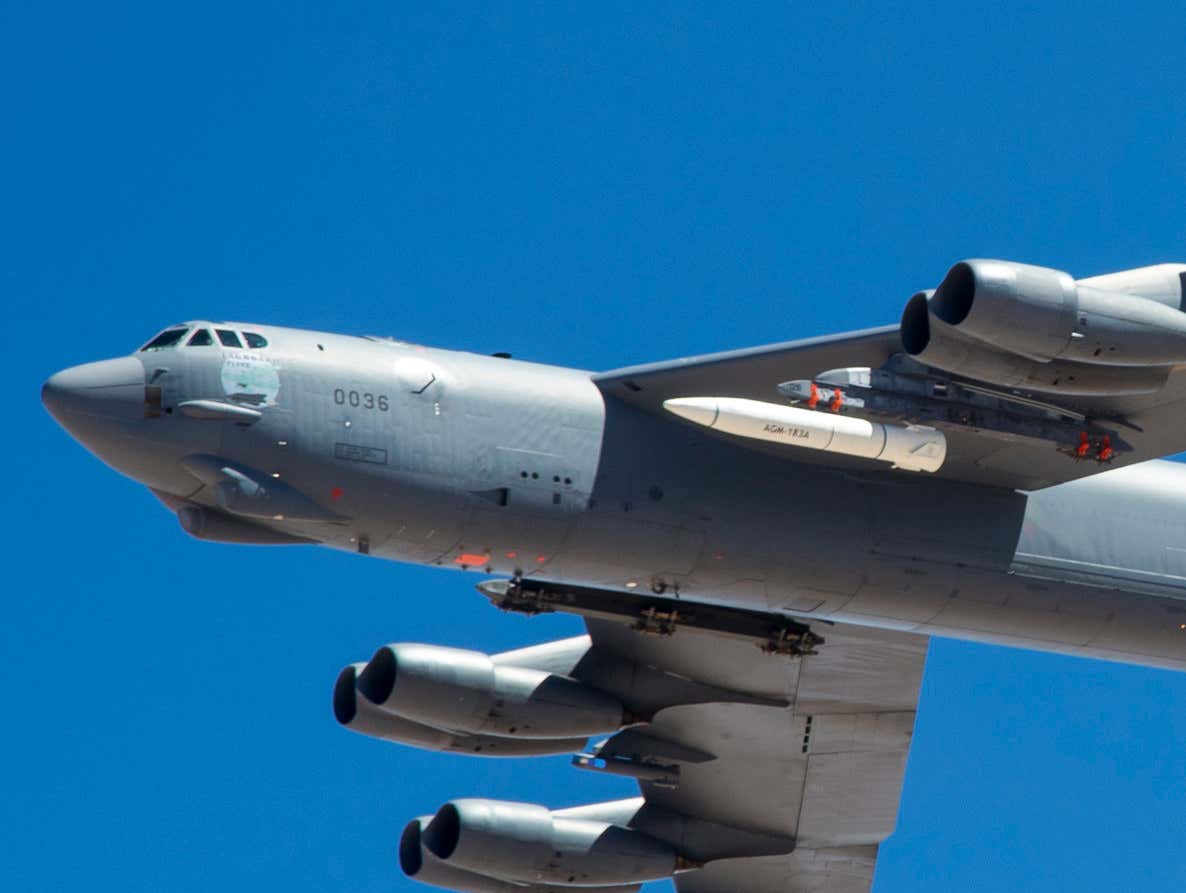
A Lockheed Martin-built AGM-183 ARRW (Air-Launched Rapid Response Weapon) hypersonic missile during a captive flight test aboard a USAF B-52.
As with all hypersonic systems, drag and the resulting thermal stresses of extremely high-speed flight are two of the biggest hurdles faced by these vehicles. Even with advanced geometry, extreme levels of heat are generated by friction on the skin of high-speed craft, which can potentially degrade the structural integrity of the airframe and damage internal components, potentially even in a catastrophic fashion.
One of the ways of mitigating that heat buildup is to add shielding to the external surfaces of an airframe. That can increase a craft’s weight and may, therefore, decrease its range, maneuverability, and top speed. Thermal shielding requirements can also be very restrictive for aerospace designers that are looking to push the limits of inter-atmospheric speed.
Tweaking a vehicle’s geometry can mitigate drag, which can also help to reduce heat buildup. However, due to the limitations of materials science and the need to include various subsystems and payloads inside of hypersonic craft, there are restrictions on just how much the geometry can be altered. Thus, there is a pressing need for other drag reduction methods to be used in conjunction with airframe geometry. Like in many other areas of cutting-edge defense and aerospace research today, that’s where breakthroughs in directed energy may be able to lend a hand.
Drag Reduction Through Directed Energy Deposition
Alongside the ongoing hypersonic revolution, the Department of Defense has been investing vast sums in directed energy systems. Many huge leaps in power and miniaturization have occurred in the last decade as solid-state systems have rapidly matured, enabling them to be used for new applications.
Laser weapons have been developed and tested for use aboard Naval vessels and even aircraft, while other forms of directed energy systems, such as high-powered microwaves, have been designed for power-beaming concepts, close-in defense systems, and anti-satellite technologies. While most discussions of directed energy focus on the potential to revolutionize anti-aircraft systems, missile defenses, or anti-satellite systems, it turns out directed energy could revolutionize high-speed aerospace propulsion and airframe design just as significantly.
Since at least the 1980s, many leading aerospace laboratories have explored the concept of “energy deposition” in order to reduce drag. This concept involves beaming energy in the form of laser filaments, electric arcs, or microwave radiation along the leading edges or just in front of an aircraft in order to condition the air to be more conducive to high-speed flight. Similar concepts have been tested in the past for different purposes, including an electron gun aboard the Lockheed A-12 designed to reduce the aircraft’s radar signature.
In a 1983 NASA-funded study conducted by the BDM Corporation and authored by Leik Myrabo, pioneer of the laser lightcraft propulsion concept, Myrabo proposed using lasers to literally explode the air in front of a high-speed craft. Myrabo’s initial concept centered on small lightcraft propelled by ground-based lasers focused on their aft section. These proposed craft would also employ internal mirrored optics to then redirect those beams forward to create a “laser-supported detonation” or “LSD wave” in front of the craft.
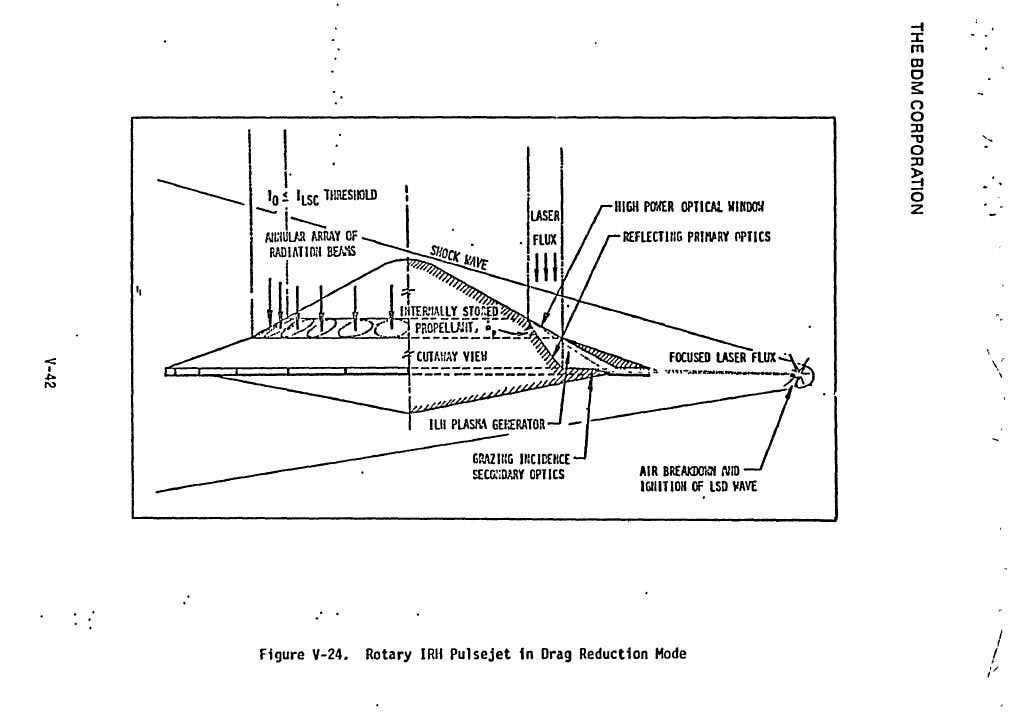
This LSD wave would create a detached shockwave “at some distance in advance of the leading edge,” which would theoretically “do the work of pushing the atmosphere out of the way and thereby suppress the formation of a strong bow shock and the associated wave drag.” The hot, pressurized gases created by the LSD wave would also theoretically then be used by the craft’s air-breathing engine, thus reducing the amount of energy required for combustion.
Myrabo updated the concept throughout the 1990s in response to the limitations of high-powered lasers at the time. In a 1995 Popular Mechanics article by Gregory Pope, Myrabo claimed that pulsed microwave energy beamed from an overhead satellite could be focused in front of a craft to “blast air into plasma,” which could then be focused downward by powerful superconducting magnets circling the craft in order to create propulsion. As Pope’s article points out, “NASA officials see promise in some of the component technologies, but envision no short-term payoff.” Myrabo’s radical concept appears to have never left the ground.
Other researchers continued exploring similar concepts, however. In 1999, Australia-based aerospace researcher H. David Froning conducted a study published by AIAA titled “Influence of EM Discharges on Hypersonic Vehicle Lift, Drag, and Airbreathing Thrust” that investigated creating “plasma formations by electric arcs or by laser or microwave radiation.” Using computational fluid dynamics, Froning found that “electric or electromagnetic discharges from hypersonic vehicles’ nose sections propagate downstream over the entire extent of the vehicles and through their engines – affecting not only nose drag, but temperatures, pressures, and total vehicle thrust, drag, and lift.” These were only computational studies, but they established a theoretical framework for developing these systems in the future.
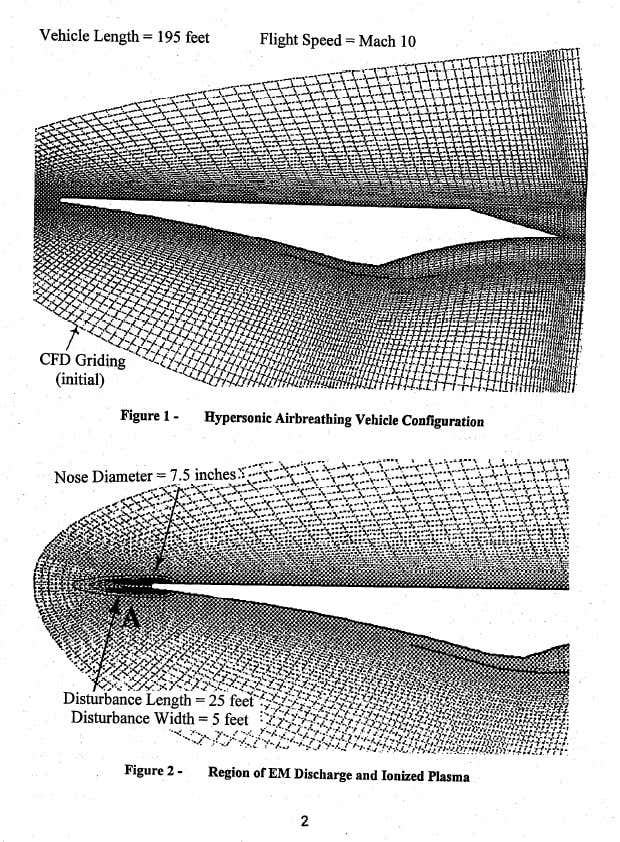
A figure from H.D. Froning’s “Influence of EM Discharges on Hypersonic Vehicle Lift, Drag, and Airbreathing Thrust”.
Throughout the last two decades, researchers in Brazil and the Rensselaer Polytechnic Institute in Rochester, New York have built upon this theoretical research and designed experiments to test energy deposition in hypersonic wind tunnels. This concept became known as the Laser-Supported Directed Energy Air Spike, or DEAS. Leik Myrabo was once again involved with the research, this time alongside a team of Brazilian researchers.
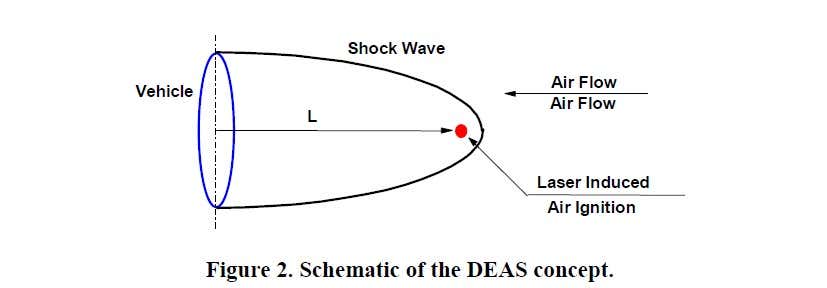
In 2005, Myrabo and Brazilian researchers testing the DEAS concept in hypersonic wind tunnels concluded that “the laser-supported DEAS was able to generate a decrease in the surface pressure over the new model tested and, therefore, a considerable decrease in the aerodynamic drag” experienced by a hemispherical test model.
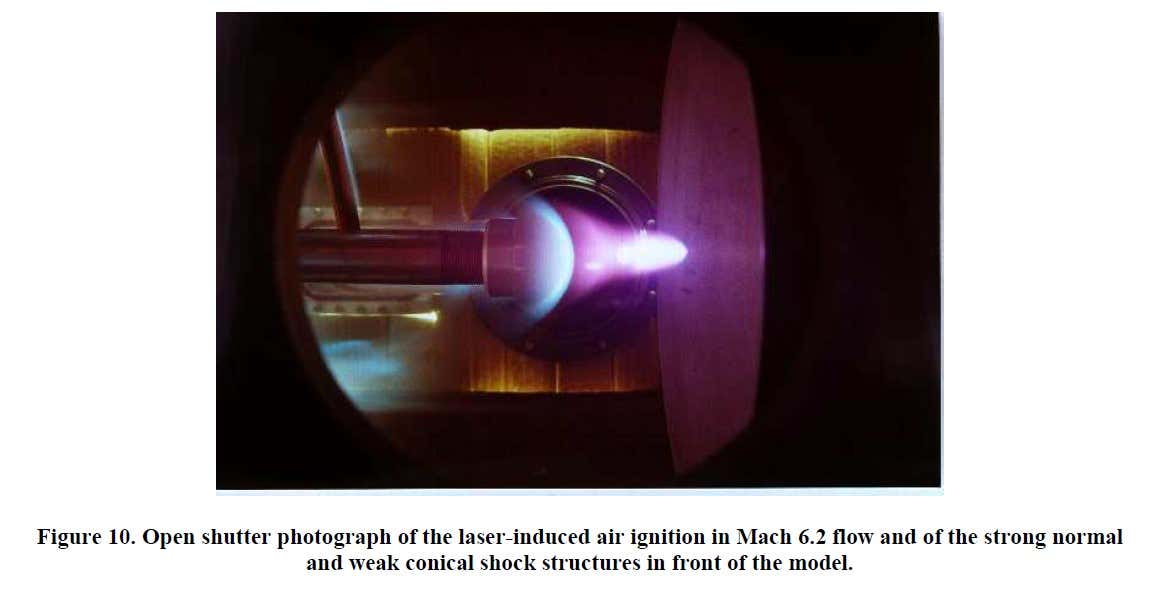
Myrabo’s concept seemed to have attracted the attention of several top laboratories. In 2010, the Journal of Propulsion and Power published the article “Review: Laser-Ablation Propulsion” which features input from personnel at the USAF Office of Scientific Research (AFOSR), Los Alamos National Laboratory, and academic institutions worldwide. The review notes that at that time, Brazilian researchers had shown that “hypersonic drag can be cut by as much as 40%” and cites cooperation between American, Brazilian, and Australian researchers on the subject of laser-aided propulsion.
By 2011, Myrabo’s team was researching the DEAS concept in cooperation with the Brazilian Air Force and the U.S. Air Force Research Laboratory. Curiously, one of the team’s publications from that year mentions a “Brazil-USA BEP cooperation” (Beamed Energy Propulsion) program, a claim that appears to be supported by additional reporting by Wired and MIT Technology Review published around the same time.
The War Zone has been unable to identify such a program. However, an AFOSR report from 2010 also mentions such a program overseen by Rensselaer Polytechnic Institute (RPI) and the Henry T. Nagamatsu Laboratory of Aerothermodynamics and Hypersonics (HTN-LAH) located at the Instituto de Estudos Avançados (IEAv-CTA) in Sao Jose dos Campos, Brazil.
According to the AFOSR report, this collaboration “was forged by the shared research goals envisioned by both parties (RPI and IEAv-CTA), and the unique facilities and equipment made available for this AFOSR research: i.e., a) the operational T3 hypersonic shock tunnel at the HTN-LAH; and, b) RPI’s two Lumonics TEA 620 lasers that were transported to Brazil with the approval of AFOSR.”

Similar energy deposition concepts have been explored by researchers at Johns Hopkins University Applied Physics Laboratory (Van Wie 2004), Rutgers University (Knight 2008; Anderson & Knight 2012), the Laboratory of Optics Applications in France (Elias 2018), and the Russian Academy of Sciences (Fomin 2004), among many other laboratories.
A search on the AIAA Aerospace Research Central database turns up over 11,000 results for various aerospace applications of energy deposition. Many major aircraft manufacturers are assigned patents for similar systems, including Boeing and Lockheed Martin.
Department Of Defense Research On Energy Deposition
The DOD has conducted its own research into energy deposition as a concept for reducing the drag experienced by high-speed vehicles. The USAF is also the assignee of numerous patents related to plasma aerodynamics.
A 2004 report commissioned by the Air Force Research Laboratory (AFRL) studied “plasmas generated by electron beams and high-voltage nanosecond pulses” and explored “aerodynamic steering using plasma energy addition” using a “microwave-driven supersonic plasma wind tunnel.” As in many exotic aerospace studies, the authors note that “Of course, fundamental issues have to be resolved prior to any practical applications.”
That doesn’t mean the DOD stopped trying to resolve those issues. In 2009, the AFRL published another study titled “Lines of Energy Deposition for Supersonic/Hypersonic Temperature/ Drag-Reduction and Vehicle Control.” The report was authored by Kevin Kremeyer, Vice President of Research at Physics, Materials, and Applied Mathematics Research (PM&AM) in Tucson, AZ. Kremeyer holds numerous patents for systems designed to reduce drag through the use of directed energy.
In the 2009 AFRL study, Kremeyer describes using laser pulses to create ionized paths in the air surrounding an aircraft and then passing an electrical current through that path, essentially forming a miniaturized lightning bolt ahead of a vehicle. By creating these ionized paths at different angles relative to an aircraft’s motion, it is claimed that novel forms of vehicle control could be accomplished that do away with external control surfaces entirely:
Kremeyer claims this could allow for more effective maneuvering at extreme speeds and notes that “each of the technical elements required to implement this technology has been demonstrated individually in the laboratory, with no apparent physical limitation barring execution as a full system.”
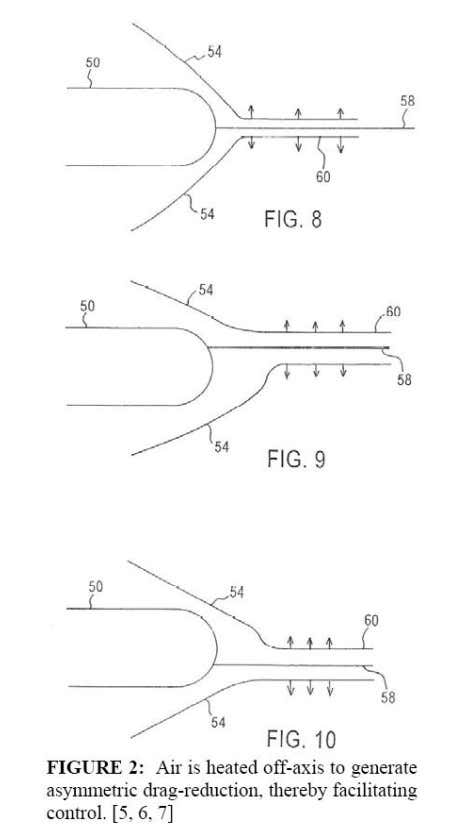
The USAF isn’t the only U.S. military branch investigating energy deposition. A 2015 study by the Naval Research Laboratory titled “Guiding Supersonic Projectiles Using Optically Generated Air Density Channels” states that a “channel of reduced air density can be generated by the energy deposited from filamentation of an intense femtosecond laser pulse” and that this channel could be used to control the trajectory of flying projectiles. While the report focuses on small projectiles instead of aircraft and describes using lasers external to the projectiles as opposed to carried aboard them, the concept remains relatively identical to other research cited here: using directed energy to reduce air pressure ahead of a vehicle or projectile’s path.
NASA even conducted a study in 2017 at the Langley Research Center into the “experimental determination of the drag reduction and energetic efficiency” of laser discharges ahead of simulated aircraft traveling at high speeds, and the Department of Energy (DOE) has looked into the same concept for increasing the performance of wind turbines.
Physics, Materials, And Applied Mathematics Research
Since 2002, Kremeyer and his firm Physics, Materials, and Applied Mathematics Research have been awarded at least 48 SBIR contracts offered by DHS, DOD, DOE, and NASA, largely focused on advanced materials, short-pulse lasers, and other directed energy applications. According to their website, PM&AM’s research largely focuses on drag reduction and hypersonic flight dynamics, and the firm claims its drag reduction technology “presents the possibility to eliminate more than 90% of the drag when flying at supersonic/hypersonic speeds.” It’s unclear how credible that claim of 90% drag reduction is, but if it turns out to be true or even remotely true, such a technology would represent a total game-changer in terms of aerodynamic performance.
In a 2019 patent, PM&AM’s Kremeyer claims that his system can reduce drag, aid propulsion, and reduce the thermal effects an aircraft experiences by ionizing and heating the air immediately around the vehicle with short laser pulses. Microwave energy is then pulsed into that laser-induced plasma to further heat the air in front of the vehicle:
Kremeyer also claims this energy deposition system could mitigate sonic booms and other noises or resonances, as well as aid in a variety of non-aerospace industrial and manufacturing processes.
In 2011, PM&AM was awarded an Air Force Phase I SBIR contract worth $99,999 titled “Laser/Microwave Energy Deposition to Improve Control/Performance of High Speed Vehicles.” The War Zone was unable to find an original listing for this SBIR offering, but one is archived on a Russian website.
According to this archived version, the objective of AF103-009 is to “develop and demonstrate laser-microwave pulsed discharges to generate surface and volumetric plasma regions in high-speed aerodynamic flows to improve vehicle performance and flight control.” The description section goes on to state that using lasers, “it is conceivable with patterned slewing, that surface and volumetric discharge clouds may be sculpted and customized to have two- or three- dimensional shapes placed strategically on or over a vehicle that could have benefits for drag reduction, vehicle steering, and, possibly, heat transfer reduction.”
The abstract and project benefits for the program as listed on SBIR.gov are as follows:
In 2013, PM&AM won a NASA SBIR contract worth $124,991 to “demonstrate the feasibility of depositing energy using basic, well-demonstrated techniques along the surface in supersonic flow to control/compress/forcibly-move the boundary layer fluid by creating a low-density ‘bubble-like’ region, thereby reducing the viscous skin friction.” A NASA.gov listing for the same contract states that the technology can be used “to improve the aerodynamic efficiency of a wide range of supersonic Government and industry platforms including supersonic business jets, commercial and military access to space vehicles, supersonic cruise vehicles, and high-speed delivery platforms.”
In 2015, PM&AM’s Air Force SBIR moved to Phase II with a new contract worth $1,199,999. In Phase II, PM&AM planned “to develop and demonstrate a laser-microwave system capable of coupling the energy of focused microwave bursts into quiescent air without the need for a microwave cavity, resulting in configuration much more applicable for improving performance of high speed vehicles.” The contract also claimed that PM&AM’s laser-microwave system would be tested at various pressure ranges experienced by hypersonic and other high-speed vehicles.
A FY 2016 DARPA funding spreadsheet found on the Executive Services Directorate website lists an identical contract number under the “Solider Protection Systems” program worth $150,000. In Kremeyer’s 2020 patent “Energy-Deposition Systems, Equipment and Methods for Modifying and Controlling Shock Waves and Supersonic Flow”, it’s claimed that the same type of laser-microwave energy deposition system could be used to protect ground vehicles from shockwaves or blastwaves produced by IEDs or other explosives. According to its website, DARPA’s Solider Protection Systems is focused on “materials and material systems that can control the energy absorption and propagation of ballistics or blasts”.
The War Zone reached out to Kremeyer and PM&AM for more information on their research, but has yet to receive a response.
To help us contextualize this research in terms of actual systems in development, The War Zone spoke with Dr. David Van Wie, head of the Johns Hopkins Applied Physics Laboratory’s Air and Missile Defense Sector. Among other aerospace and defense topics, Van Wie has published extensively on energy deposition drag reduction systems and other plasma-based aerodynamic concepts, and led AFRL’s “Advanced Physics System Study for Future Aerospace Vehicles.”
Van Wie told The War Zone that while the levels of power required for the energy deposition systems cited above are indeed possible given today’s aircraft power systems, the accompanying weight that must be accommodated into any aircraft drag reduction system would offset some of the gains that system could produce. “A one-megawatt generator riding on a turbine engine is a fairly heavy system to get integrated into any practical aircraft,” he said. “It’s not that you couldn’t do it, but it ends up being a weight challenge to generate any appropriate level of power to have a reasonable drag reduction.”
He pointed out that efficiency is key to energy depositions for drag reduction, as the levels of drag reduction must be weighed against the added weight and power requirements. “The drag reduction system has to be more efficient than what you could get out of an engine or it doesn’t make sense to use drag reduction; you’d just build a bigger engine.”
Van Wie is not aware of any actual flight testing of these types of energy deposition systems, as it still remains quite complex and expensive to integrate such a system into an aircraft. In addition, he noted there are “still relatively significant uncertainties about the efficiency that a system like this could operate with, even given all of the academic and wind tunnel papers that have been generated. There’s still quite a bit of uncertainty about the performance that can be realized.”
Still, Van Wie said that the quite significant levels of drag reduction cited by Kremeyer and others are “not just theoretical” and have been realized in wind tunnel testing, although those tests often involve blunt test bodies and other non-aircraft shapes. “The real question is what kind of efficiency can I get on a system that’s more optimized for a flight vehicle, an aerodynamic shape, which is fundamentally designed to not have a lot of drag,” he told The War Zone. “The question of efficiency is tied ultimately to questions of shapes and such, and so you have to answer those questions together. Can I get high efficiency both in a configuration that would be typical of those that we use for flying vehicles which are highly aerodynamically efficient already?”
A Possible Glimpse At What’s To Come
Interest in hypersonic weapons and vehicles have exploded across the aerospace defense-industrial complex, with massive contracting opportunities popping up across the board. The Pentagon’s appetite for hypersonic weapons has grown so immense and pressing that it has issued contracting opportunities for what appears to be literally any hypersonic technology.
Alongside the burgeoning hypersonic revolution, directed energy systems continue to become smaller and more powerful, and applications like the energy deposition concepts cited above seem far more possible than they were in decades past. DoD research into solid-state laser technology has made directed energy weapons much more portable, enabling them to be installed aboard surface vessels or in pods aboard aircraft. It’s no stretch of the imagination to say that directed energy systems could eventually be miniaturized and efficient enough to be used in drag reduction or flow control systems.
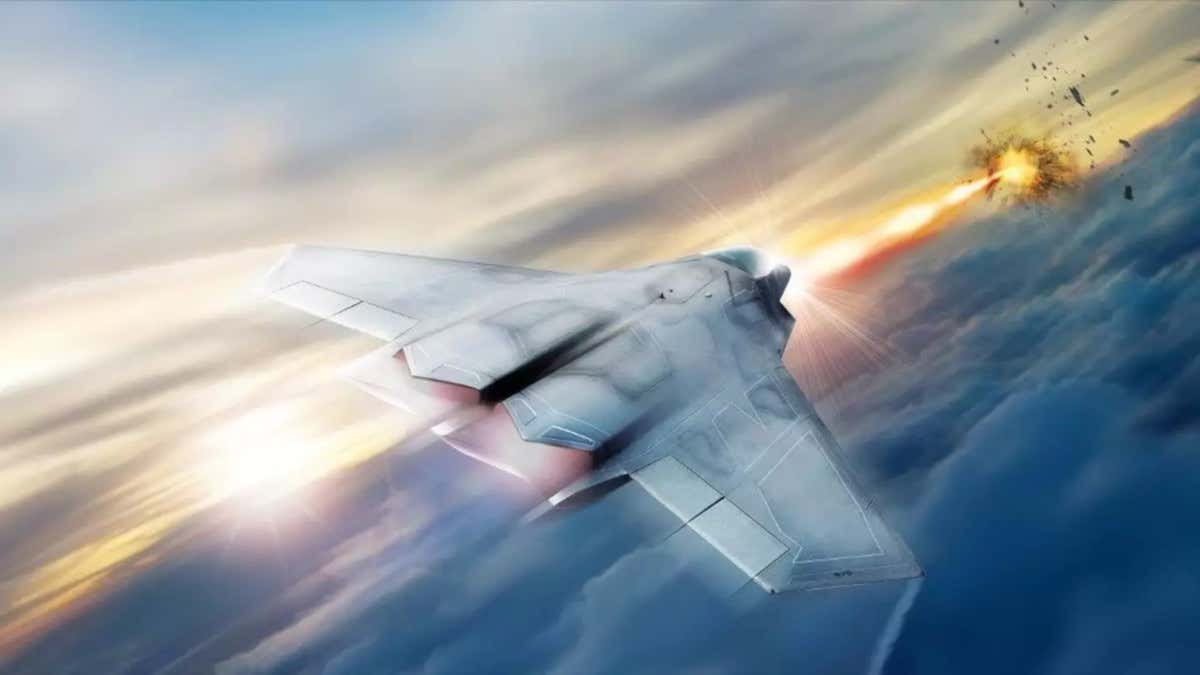
Artist’s rendering of a future aircraft neutralizing a threat with a directed energy weapon.
The energy deposition research cited above is a rare case in which two of the Department of Defense’s most cutting edge areas of research could potentially combine to form an entirely new and utterly formidable capability: hypersonic vehicles that can fly extremely efficiently at incredible speeds, a feat made possible by revolutionary new applications of lasers and microwaves that are coupled to tailored aerodynamic shapes and hypersonic propulsion.
Of course, all of the research cited above is only a glimpse into what has been published publicly. There is no doubt energy deposition research at various stages in the classified world, as well. Especially now. Given that the DoD is poised to spend over $71 billion on classified programs in 2021, one can only imagine what types of undisclosed hypersonic platforms and directed energy systems are being developed given that these are two of the most strategically competitive areas of weapons development today.
As these two areas of cutting edge technological research continue to merge in the form of energy deposition for aerodynamic control, entirely new forms of aircraft design, propulsion, and control may arise and unlock new frontiers in terms of velocities that are attainable within Earth’s atmosphere.
Contact the author: [email protected]
